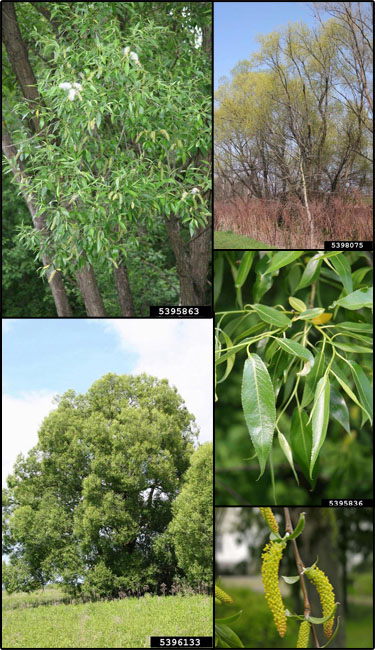Crack willow (Salix fragilis)
 Common Names: Brittle willow
Common Names: Brittle willowDescription: It was introduced to North America as a fast-growing ornamental.
Habit: Large, deciduous tree; growing up to 65 ft in height; often divides into several large branches low on the trunk or at ground level.
Leaves: Alternate, long, lanceolate or linearlanceolate, 2.8-5 in long and 0.6-1.2 in wide, finely serrate, shiny yellowish-green above, pale to white-hairless below.
Stems: Dark brown or dark gray bark is deeply divided into scaly forking ridges, 65 ft in height.
Flowers: Grouped catkins 1.2-2.4 in long at ends of short leafy branches; small, yellowish hairy scales; pistillate and staminate on different trees; bloom in early spring.
Fruit and seeds: Numerous conical fruit capsules release many small cottony-tufted seeds, germinate immediate after wind or water dispersal on moist, bare mineral soils.
Habitat: Native to Eurasia. Grows in light (sandy), medium (loamy) and heavy (clay) soils that are acid to neutral and moist or wet; found along streams, marshes, fens, wet woods and disturbed areas with moist soils.
Reproduction: Vegetatively by twigs breaking off and taking root, and from root suckers.
Similar species: Black willow (Salix nigra).
Monitoring and rapid response: Cut tree off at or just above ground level as level as possible then apply herbicides; effectively controlled using a water registered glyphosate product. Credits: The information provided in this factsheet was gathered from the USDA PLANTS Database and the U.S. Department of Agriculture, Forest Service.
Individual species images that appear with a number in a black box are courtesy of the Bugwood.org network (http://www.invasive.org).Individual photo author credits may not be included due to the small display size of the images and subsequent difficulty of reading the provided text. All other images appear courtesy of Google (http://images.google.com).
Common Name: | Crack willow |
Scientific Name: | Salix fragilis |
Family: | Salicaceae (Willow) |
Duration: | Perennial |
Habit: | Trees |
USDA Symbol: | SAFR |
